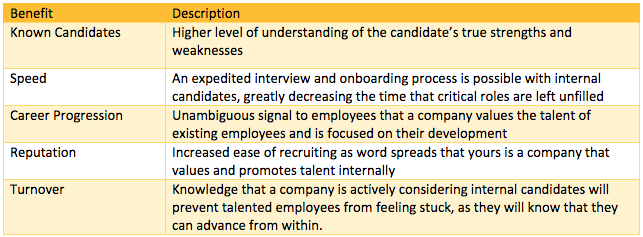Internal Hires: The Keystone of a Successful Talent Management Strategy

For more than 20 years, the defining concept of talent management in executive circles has been “the war for talent.” First posed by McKinsey & Co. in 1998, the idea was simple and compelling at its birth: Talent is a significant driver of business success, and demographic trends would force companies to devote increasing amounts of time, effort, and money to attracting, retaining, and engaging talented employees.
The basic conclusion that talent is a significant driver of value is supportable, as are the assertions that retaining and engaging talent are high-ROI endeavors. However, with the benefit of hindsight, it becomes easier to see some of the ways in which McKinsey’s war for talent model falls short:
1. Availability
The war for talent is pitched as a zero-sum game, which assumes talent scarcity is an unchangeable given. This view is both unnecessarily bleak in a philosophical sense and wrong in a tactical sense. Thanks to a proliferation of professional development resources — as well as proven techniques such as mentoring and stretch assignments — the talent pool can obtain the technical and leadership skills employers are looking for, thus meeting organizational demand.
2. Definition
The war for talent model defines “talent” too narrowly. According to it, there are rock star talents, and then there are the rest of us. This is a toxic view, but one that many managers adopt when they mistakenly ascribe the cumulative effort of a number of team members to a single rock star.
As a direct result of this faulty definition, organizations often recruit highly talented outsiders without accounting for the supporting factors that are crucial to any individual’s success — factors like coworkers, relationships inside and outside the company, etc. Many stars prove to be dependent on these factors, and their performance reverts to the mean when these supports are lacking. This reversion to the mean is dispiriting for the star, fosters ill feelings among internal candidates who might have done better in the role, and places managers in an unfortunate position: having to address the reality that, despite their efforts, they have not adequately filled an existing skill gap.
3. Fit
Cultural fit should never be assumed, yet many leaders and managers operate as if talented insiders are able to jump into any culture and thrive immediately.
Inside of every company, employees develop intricate interpersonal networks that make a mockery of formal org charts but drive how business is done at the company. Without understanding and integrating into these networks, talented outsiders will stumble.
Additionally, new employees — especially those in positions of authority — run the constant risk of violating the principle of Chesterton’s fence, which holds that changes should be deferred until the reason for the current state of affairs is understood. Outsiders may be moved to make major changes without fully understanding the organizational environment, potentially leading to disaster.
Benefits of Hiring From Within
While the war for talent model encourages aggressive external recruiting, we should reevaluate our talent strategies in light of the model’s flaws. So, what is an executive or hiring manager to do when looking to fill a role?
In our analytics-driven age, the answer is simple: Take the high-percentage shot by hiring from within. Hiring internally does a great deal to mitigate risk and create virtuous cycles that strengthen a business considerably over time:

Measuring the Impact of Hiring Internally
To appreciate the full range of benefits afforded by hiring internally, we have to avoid taking too narrow a view of those benefits. The amount saved on hard costs — such as allocated staff costs, incremental compensation costs, and outside recruiting costs — is a good starting point. However, we must also account for “soft” costs like reduced training time, better cultural fit, lower turnover, and increased ease of recruiting.
An emphasis on internal hires does not invalidate an existing talent management strategy but should rather be seen as a key tactic in executing that strategy. Once they’ve recognized that talent can be a positive-sum resource rather than a zero-sum game, businesses can see the wisdom in investing in internal hiring as a valuable and necessary component of a successful talent management strategy.
David Johnson is founder and managing partner of Abraxas Group. He can be contacted at: david@abraxasgp.com.

